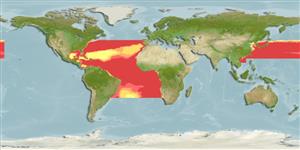Teleostei (teleosts) >
Myctophiformes (Lanternfishes) >
Myctophidae (Lanternfishes) > Diaphinae
Etymology: Diaphus: Greek, dis, dia = through + Greek, physa, phyo = to beget, to have as offspring (Ref. 45335).
Eponymy: Dr Åge Vedel Tåning (1890–1958) was a Danish ichthyologist and an expert on lanternfish. [...] (Ref. 128868), visit book page.
More on author: Norman.
Environment: milieu / climate zone / depth range / distribution range
Ecology
Marine; bathypelagic; depth range 40 - 475 m (Ref. 4479). Deep-water; 42°N - 27°S
Eastern Atlantic: Mauritanian Upwelling region and Gulf of Guinea south to 23°S. Western Atlantic: USA (Gulf Stream) to Gulf of Mexico and the Caribbean Sea. Northwest Atlantic: Canada (Ref. 5951). Reported off the Guianas (Ref. 13608).
Length at first maturity / Size / Weight / Age
Maturity: Lm 3.8, range 4 - 4 cm
Max length : 7.0 cm SL male/unsexed; (Ref. 4479)
Pseudoceanic, found over continental shelves and slopes (Ref. 4066). Occurs between 325-475 m during the day; between 40-250 m at night (maximum abundance in 100 m depth). Mesopelagic (Ref. 5951). In the Cariaco Trench, day distribution is at 250 m and at night at 50 m due to anoxic conditions below 400 m and free hydrogen sulphide below 375 m. Fecundity is about 1,000 eggs per female (Ref. 9504).
Life cycle and mating behavior
Maturity | Reproduction | Spawning | Eggs | Fecundity | Larvae
Hulley, P.A., 1990. Myctophidae. p. 398-467. In J.C. Quero, J.C. Hureau, C. Karrer, A. Post and L. Saldanha (eds.) Check-list of the fishes of the eastern tropical Atlantic (CLOFETA). JNICT, Lisbon; SEI; Paris; and UNESCO, Paris. Vol. 1. (Ref. 4479)
IUCN Red List Status (Ref. 130435: Version 2024-2)
Threat to humans
Harmless
Human uses
Tools
Special reports
Download XML
Internet sources
Estimates based on models
Preferred temperature (Ref.
123201): 11.1 - 23.6, mean 17.9 °C (based on 395 cells).
Phylogenetic diversity index (Ref.
82804): PD
50 = 0.5000 [Uniqueness, from 0.5 = low to 2.0 = high].
Bayesian length-weight: a=0.01000 (0.00438 - 0.02284), b=3.04 (2.86 - 3.22), in cm total length, based on LWR estimates for this Genus-body shape (Ref.
93245).
Trophic level (Ref.
69278): 3.3 ±0.2 se; based on diet studies.
Resilience (Ref.
120179): High, minimum population doubling time less than 15 months (Preliminary K or Fecundity.).
Fishing Vulnerability (Ref.
59153): Low vulnerability (10 of 100).
